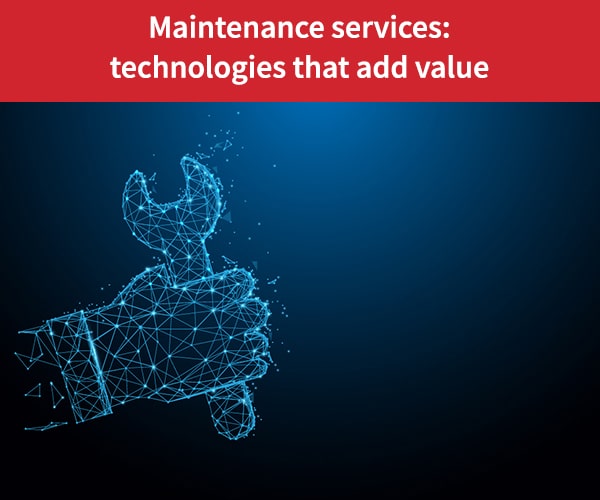
- Productivity
- Field Service Management
- Artificial Intelligence
- Technologies
- Productivité
- Gestion d’interventions
- Productivité
6 technologies that help maintenance providers add value
Today, there are a number of technologies that allow maintenance providers to remotely interact with customers and troubleshoot issues. From community spaces and video tutorials to chatbots, voice assistants and augmented reality, maintenance providers have new opportunities to reduce the number of site visits they make and the cost of service.
The goal is to reserve technician visits for service calls that truly provide added value for the customer and the maintenance company.
Each site visit has two costs: the cost for the maintenance company to send the technician to the customer site and the business cost to customers who are stuck with non-functioning equipment or stopped production lines.
Any measures that help to avoid on-site visits are important measures to take. With this in mind, there are a number of solutions that are designed to remotely resolve issues other than unavoidable customer support issues. Here are 6 to consider.
1. A community support space
Every maintenance company’s website should include helpful resources such as technical guides and tutorials as well as frequently asked questions (FAQs). When a community support space is provided, customers can also exchange tips and best practices.
This area of the website functions as a discussion forum where people with more experience can add value by using their expertise to answer questions and help less experienced customers troubleshoot issues. The maintenance provider just has to moderate the exchanges.
Telecom companies and software vendors have made these types of communities common. In fact, if you enter a question or a problem in a search engine, it’s usually these types of peer discussions that are at the top of the results list. When you click through to the discussion page, you can search for answers by theme or using keywords.
2. Video tutorials
Video tutorials require a bigger investment, but are often better than providing long text documents because they can address specific aspects of maintenance and troubleshooting in just a few minutes.
To make video tutorials, you may need to acquire screencast software that can record computer and smartphone screens and combine the accompanying audio commentary with the visuals. Open source and freemium screencast software such as CamStudio, iSpring Free Cam, MadCap Flare, Screencast-O-Matic and PicPick are available to help keep costs down.
3. A chatbot to answer common questions
The next step in remote customer support is automating first-level support. Chatbots can be connected to a knowledge base to answer common customer questions.
With these conversational customer support agents, technicians no longer need to spend time responding to basic IT helpdesk requests such as how to reset passwords. Chatbots are available 24/7, have no wait times and, best of all, complement traditional customer support contact channels such as call centers, email and chat.
Chatbots act as a sort of dynamic and interactive FAQ that can proactively send customers the relevant data sheet or tutorial, saving them having to search the website for the information. When chatbots can’t provide the answer, they can determine who is the best person to answer the question and forward the request to them. The person who receives the request can access the chatbot’s exchanges with the customer so they’re not starting from scratch.
4. A voice assistant
About three years ago, chatbots gave rise to voicebots. As the name implies, voicebots use voice rather than text to exchange information. With Siri, Alexa and Ok Google, everyone has a virtual assistant in their smartphone or smart home device.
Because it’s more natural for humans to talk than to type, interactions with voice assistants are easier. While the voice assistants listed above have mainstream appeal, offerings such as Amazon’s Alexa for Business or IBM’s Watson Assistant provide virtual assistants for professionals. Web companies also develop voicebots for business-to-business (B2B) applications.
Professionals on-the-move can use natural language to describe an equipment problem and get an immediate response. The voicebot never experiences stress or fatigue, is always in the same mood and has infinite patience.
The latest generation of connected speakers with screens from Amazon Echo Spot, Google Home Hub and Facebook Portal, also offer a hybrid approach where the user speaks to the wizard and the wizard automatically plays the relevant video tutorial.
5. A voicebot to replace IVR
Callbots, another member of the bot family, are like voicebots that are dedicated to telephony. Callbots offer advantages over interactive voice response (IVR) systems because callers can simply state their request over the phone without having to choose options 1, 2, or 3.
As Google has demonstrated, bots can also initiate phone calls. With the company’s new service, Duplex, the web giant uses technology to make phone calls so people don’t have to. This video demonstration shows how Duplex can be used to make a reservation at a restaurant or a hair salon.
In terms of maintenance services, picture a bot scheduling a preventive maintenance appointment with a customer or asking the questions that a call center agent would ask before scheduling an on-site visit by a technician.
In the case of computer issues, the bot could ask standard IT questions, such as “is the computer plugged in” and “have you restarted the computer”? Going a step further, the bot could remotely access the computer to make an initial health check without having to ask what’s showing on the screen.
6. Augmented reality
Augmented reality also helps people work more autonomously. For example, contextual information such as drawings, technical data sheets and lists of questions can be superimposed on the real world and displayed within peoples’ field of vision.
French telecommunications company, SFR, plans to use augmented reality to help its customers install equipment in their homes. These tasks create headaches for many cable and fiber service subscribers, generating high numbers of support calls and customer visits.
Because the installation information has moved into the customer’s world, they can more easily make the right connections. Technicians and customers can share a video channel so the technician can supervise the customer’s actions step-by-step over the phone until the customer is finally successful… and the technician didn’t have to move.
Our similar articles.
-
- Productivity
- Field Service Management
- Gestion d’interventions
- Optimization
- Productivité
How field service management software drives business growth
August 21, 2018 -
- Software
- Field Service Management
- Logiciel
- eco-driving
What eco-driving means and how to implement it at work
November 23, 2022 -
- Mobility
- Maintenance
- Internet of Things
- Mobile App
- Technologies
- Application mobile
What 5G will bring to maintenance and field service companies
June 9, 2021


